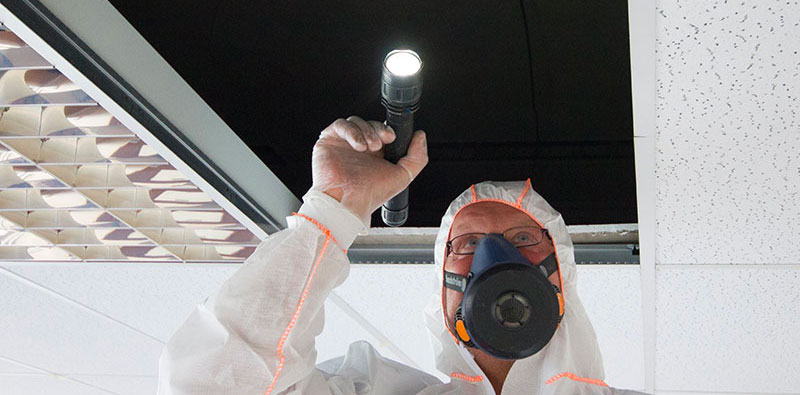The Total Refine of Accredited Asbestos Checking to Make Certain Home Compliance
In the realm of residential property monitoring and conformity, the procedure of approved asbestos testing stands as an essential component to ensure the safety and security and health of owners. From the preliminary analysis to the last interpretation of results, each stage plays a crucial function in identifying the presence of asbestos within a residential or commercial property.
Accredited Asbestos Testing: First Assessment
In performing the first analysis for approved asbestos screening, a thorough exam of the building's materials is imperative to precisely identify prospective asbestos-containing products. This essential action involves aesthetically evaluating all areas of the residential or commercial property, consisting of ceilings, wall surfaces, flooring, insulation, and other structure products that may harbor asbestos. Special focus is provided to materials that are susceptible to harm or disruption, as these situations can release dangerous asbestos fibers right into the air. Additionally, sampling of presumed products may be needed to verify the presence of asbestos with lab analysis.
Recognized asbestos assessors adhere to strict procedures set by regulatory bodies to make sure the precision and dependability of the screening process. By diligently documenting searchings for and making use of innovative testing approaches, assessors can provide homeowner with a thorough record describing the presence of asbestos, if any, and the recommended actions for reduction or removal. This initial analysis establishes the structure for succeeding activities to resolve asbestos concerns and ensure the safety and compliance of the home.
Sample Collection Treatments for Asbestos Evaluating
Reliable sample collection procedures are vital in making certain accurate asbestos screening outcomes and conformity with regulative criteria. When gathering samples for asbestos screening, it is crucial to comply with strict procedures to decrease the danger of contamination and make certain the reliability of the outcomes.
To start with, it is necessary to identify the thought asbestos-containing products (ACMs) and prioritize tasting areas based upon elements such as the product's problem, accessibility, and capacity for disruption. Asbestos Testing. Samples need to be accumulated from different locations within the residential property to offer a detailed assessment of asbestos visibility
Throughout sample collection, accredited specialists ought to put on proper personal safety devices (PPE) to secure versus asbestos direct exposure. They must use clean tools, such as non reusable handwear covers and plastic bed linen, to avoid cross-contamination between samples. Samples ought to be thoroughly gathered making use of a defined strategy, such as damp cleaning or coring, and firmly secured in impermeable containers to preserve their integrity throughout transportation to the lab for evaluation.
Lab Evaluation Process for Asbestos Examples
Upon completion of the example collection process, the asbestos samples are thoroughly carried to accredited research laboratories for precise evaluation. At the laboratory, you could try this out educated specialists take care of the samples with extreme treatment to stop any cross-contamination or example degradation. The very first step busy analysis process is example preparation, where the gathered examples are carefully processed to extract the asbestos fibers. Asbestos Testing. This step is important to make sure exact lead to the succeeding evaluation. Clicking Here

As soon as the evaluation is full, a detailed report is generated, detailing the findings and validating whether asbestos exists, the kind of asbestos fibers identified, and the concentration levels. This info is vital for residential or commercial property proprietors to take the essential steps to guarantee compliance with asbestos guidelines and secure the wellness of owners.

Reporting and Interpretation of Asbestos Test Outcomes
Certified asbestos screening laboratories give in-depth records that provide critical understandings into the visibility, type, and focus levels of asbestos fibers found in examples gathered from residential or commercial properties. These records are important for homeowner and supervisors to comprehend the danger positioned by asbestos and make notified decisions regarding its management or elimination. The records normally include info on the approaches used for testing, the locations from which examples were taken, the kind of asbestos identified (such as chrysotile, amosite, or crocidolite), and the concentration levels of asbestos fibers discovered.
Translating these outcomes calls for proficiency to evaluate the prospective wellness threats related to asbestos direct exposure, determine the ideal program of action, and ensure regulative conformity (Asbestos Testing). Relying on the searchings for, recommendations may vary from continued monitoring and upkeep to encapsulation or full asbestos reduction. Homeowner must meticulously review these records and consult with asbestos experts to create an extensive prepare for resolving any asbestos concerns recognized
Guaranteeing Home Conformity With Asbestos Laws
To keep adherence with asbestos guidelines, home proprietors need to faithfully carry out measures to guarantee conformity with applicable laws and guidelines. This includes performing normal asbestos evaluations by approved experts to recognize any existence of asbestos-containing products within the home. As soon as asbestos is recognized, homeowner must comply with asbestos monitoring plans that summary correct control, removal, or encapsulation procedures to protect against exposure and spread of asbestos fibers. Compliance also includes maintaining thorough records of asbestos screening, upkeep, and removal activities for inspection objectives.
Home owners ought to offer asbestos understanding training to staff members and owners to decrease the threat of asbestos direct exposure and make sure appropriate handling of materials that may have asbestos. In addition, it is critical to remain notified regarding any updates or changes in asbestos laws to readjust management practices as necessary. By proactively resolving asbestos conformity check out here demands, homeowner can develop a secure atmosphere for residents and mitigate possible lawful and health risks linked with asbestos exposure.
Conclusion
To conclude, approved asbestos testing is an essential procedure for making sure home compliance with laws. The preliminary assessment, example collection procedures, research laboratory analysis, and interpretation of outcomes are very important actions in this process. By following these treatments, residential or commercial property proprietors can determine and address any type of asbestos hazards existing, safeguarding the health and wellness of owners and preserving conformity with regulative needs.